Agroha
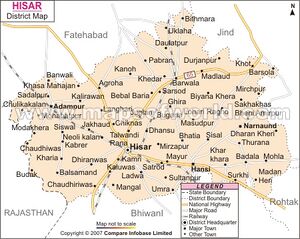
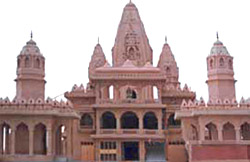
Agroha (अग्रोहा) is an ancient town in Hisar district in Haryana. It was known as Agrodaka (अग्रोदका) in ancient times during period of Vikramaditya.[1]
Location
It is close to Hisar on NH 10, located 20 Km`s North-West of the City of Hisar. Coordinates:29.20 N 75.38 E.
Variants of name
- Agraha (अग्राहा) (AS, p.10)
- Agrodaka (अग्रोदक) (AS, p.11)
- Agodaka (अगोदक)
- Agroha (अग्रोहा) (AS, p.11)
History
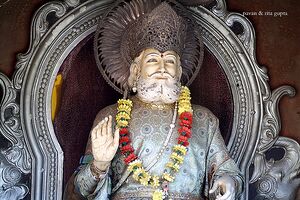
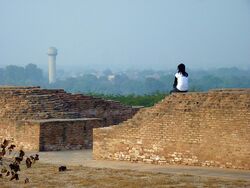
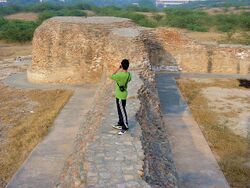
Agroha took its name from King Agra. Archaeological evidences tell us that the town was established earlier than fifth century before Christ. Kushan and Yaudheya coins, bricks with designs of human heads with typical hair styles, terracotta seals and sculptures are among the finds discovered. It is believed to be the birthplace of the Agrahari and Agrawal communities. Ancient structures, pot-shards, coins and seals have been found in archaeological excavations. Agroha was the capital of legendary Emperor Agrasen.
Three thousand years back, Agroha was the kingdom of Maharaja Agrasen. The Agroha Mound or `Ther` is situated about 1.5 km away from the present Agroha village. Buried under this mound are the remains of the ancient town. Its excavation was started in the year 1888-89. It was at this time that people came to know about this great kingdom. Agroha is situated in the district of Agroha Haryana and in it lies buried the ruins of the capital of the Agroha State. The ancient Agroha town existed some hundred years before the Kushan dynasty. Once the state was renowned for its prosperity. As time passed it could not stand the invasions of Greeks, Yavanas and Hunas. The invasions led to the migration of Agroha residents to other parts of India like Rajasthan, Uttar Pradesh, Punjab and Malwa. They people got the common name Aggarwals that means Agroha-Wale. From the excavations it is clear that below the mounds existed a big, well planned and progressive town. Large number of silver and bronze coins of different shapes and sizes has been discovered from the excavated site. The scripts on the coins prove that they belong to different periods. Statues made of stone and sand was also excavated from the site. There are many utensils belonging to the 2nd century BC.
The Agroha Mountain goes back to the 3rd century BC and it is the place where Harappan coins were discovered apart from stone sculptures, terracotta seals, iron and copper implements, shells etc. The Agroha mound consists of the Agroha Temple Complex on one side and the Sheela Mata Temple on the other side.
It was in these lands that the very first evidence of the presence of man was discovered with the excavation of Agroha, Banawali and Kunal. All of these were the pre-Harappan settlements, bringing for us the very first images of prehistoric times. The presence of the pillar in the Hisar Fort belonging to the time of Emperor Ashoka (234 BC) was originally from Agroha. The discovery of coins of the Kushan Kings tells tales of ancient India.
The Varhneyas, a section of the vaishy community, known as Barah-Senis in Uttar Pradesh, who claim Agroha as their original home, are believed to be the descendants of the ancient Vrishnis. [2] Vrishni was born as eldest son of Maharaja Madhu in 19th generation of Yadu, the son of Yayati. He is a Chandravanshi Jat kshatriya. Vrishnis were the descendant of Vrishni. Krishna belonged to this branch of the Chandravanshi of Vrishnis from whom he got the name Varshneya. [3]
Excavation of Agroha
Dr Naval Viyogi [4] writes.... [p.378]: Mound of Agroha is situated on the metalled road between Hissar and Fatehabad at a distance of 14 miles from the former. A series of rolling mounds of varying heights being about 87 feet above the surrounding ground level occupy about 650 acres of land towards the north-west of the village known by the name of Agroha. Tradition avers that Raja Agra later named Aggrasain , used to live here and the remains of fort on the top of the mound are connected with his residence.[5]
It can be said with a certain degree of accuracy that Agroha owes its origin to Agra and eancient name of the town was Agrodaka, as marked on the coins found in the excavation. The fort, however, on the top was constructed by Dewan Nannomal, who was an Aggarwal by caste and was the employee of Raja Amar Singh of Patiala (1765-1781). (Griffin, Punjab Rajas and Panjab state Gazetteers Vol XVII A).[6]
Agroha appears to have been mentioned by Ptolemy, who calls it Agara, which can not be identified with Agra (U.P.) In the medieval period Zia-u-d-din Barani[7] Afif have described Agroha or Agrah as a flourishing town forming an important division of the newly laid town of Hisar-i-Firuza. The severe famine in Muhammad Tughluq's time had caused considerable havoc at Agroha and it was deserted city as evidenced by Ibn-i-Batuta.[8] Its excavation work was conducted by M.C.J. Rodgers in 1888-89 and again in 1938-39 by H.L. Srivatava joint director of Archaeology in India. One sculpture pieced together found in 7L/4 at a depth of 9.4 represents an image standing on lotus supported by Nagas[9] and one of the terracotta Mahisasurmardini, a seated image with a female standing by, proves that residents were Nagas and mother goddess worshippers.
A small hoard[10] of five silver coins buried in a pottery vase was found in square 7 P/3 at a depth of 14', It contained one coin each of Antiolkidas, Apollodotos, strabo, Amyntos, and one Punch marked coin with solar and tree symbol. The other hoard of 51, mostly rectangular coins, buried in a wide mouthed pottery vase was found in the same square and at the same depth. These coins contained the inscription Agodaka Agācha janapadas with tree in railing on the obverses and bull, lion and in three instances composite with part of the same inscription on the reverse. These coins established the identity of Agroha with the ancient Agrodaka founded by Agra, the reputed fore-father of the Aggrawals. [11]
These were Sanghas or republicans of ancient period, who met with Alexander as cited earlier. The recovery of Indo-greek coins and the Agodaka coins in the pit have so far established the antiquity of the site
[p.379]:to about second century BC. [12] It seems Agrasenis migrated from west Punjab and settled here. Solar symbol on coins shows that they were worshippers o Sun god or Baal.
अग्रोहा
विजयेन्द्र कुमार माथुर[13] ने लेख किया है ...अग्रोहा (AS, p.10) वर्तमान अग्राहा या अग्रोहा प्राचीन अग्रोदक या अग्रोतक है। अगरोहा हरियाणा के हिसार ज़िले में स्थित नगर जो आग्रेय गणराज्य की राजधानी था। स्थानीय किंवदंती के अनुसार महाभारत काल में यहां राजा उग्रसेन की राजधानी थी और स्थान का नाम उग्रसेन का ही अपभ्रंश है। यवन-सम्राट अलक्षेंद्र के भारत पर आक्रमण के समय (327 ई. पू.) यहां आग्रेय गणराज्य था। चीनी यात्री चेमाङ् ने भी अग्रोदक का उल्लेख किया है।
जाट इतिहास
दलीप सिंह अहलावत के अनसर धारण गोत्री गुप्त सम्राटों के वैवाहिक सम्बन्ध जाटवंशों में ही रहे। जैसे चन्द्रगुप्त प्रथम की महारानी कुमारदेवी लिच्छवि जाटवंश की राजकुमारी थी जो कि सम्राट् समुद्रगुप्त की माता थी। समुद्रगुप्त की महारानी दत्ता महादेवी यौधेय जाटवंश की राजकुमारी थी जिसके प्रथम पुत्र रामगुप्त का जन्म पाटलिपुत्र में हुआ और उसी से दूसरे पुत्र चन्द्रगुप्त द्वितीय विक्रमादित्य का जन्म अग्रोदका (अग्रोहा) में हुआ जो यौधेयों की राजधानी थी जिसका शासक उसका पिता था। रामगुप्त की पटरानी ध्रुवदेवी मालव या मल्ल जाटवंश की पुत्री थी। ध्रुवदेवी अपनी सास दत्तादेवी और परसास कुमारदेवी की योग्य बहू थी।[14]
स्वामी ओमानन्द सरस्वती के अनुसार छठी शताब्दी में जाट राजा हर्षवर्धन उत्तर भारत के सर्वशक्तिमान् सम्राट् थे जिनके राज्य-प्रबन्ध की प्रशंसा चीनी यात्रियों ने भी की है । इन्हीं के राज्य में बाण जैसा कवि था जिसके सम्बन्ध में प्रसिद्ध है कि "बाणोच्छिष्टं जगत् सर्वम्" । संस्कृत साहित्य का कोई ऐसा शब्द न होगा जिसका बाण ने प्रयोग न किया हो । सौलह सौ वर्ष पूर्व उत्तर भारत में जाटों के अनेक उदाहरण थे जिनमें रोहतक का यौधेयगण राज्य सर्वाधिक प्रसिद्ध था । यहाँ के वीर क्षत्रियों ने अपने रक्त की अन्तिम बूंद तक बहाकर पंचायती राज्य की रक्षा के लिए अकथनीय बलिदान दिये । उनके समृद्धिशाली राज्य की कहानी रोहतक का खोखरा कोट पुकार-पुकार कर कह रहा है । थानेसर, कैथल, अग्रोहा, सिरसा, भादरा आदि इनके प्रसिद्ध जनपद थे । [15]
Jat Gotras
Jat Gotras in Agroha are:
Population
Notable persons
- सतपाल सिंह भाकर: अपने पिता के इकलौते लाल सतपाल सिंह भाकर लेह लद्दाख में शहीद दो बेटियों के पिता और दो बहनों के इकलौते भाई हरियाणा के हिसार के अग्रोहा के साधारण किसान परिवार में जन्मे भारतीय सेना के जवान सतपाल भाकर (30) ने भारत मां की रक्षा करते हुए अपने प्राण न्योछावर कर दिए। शहीद के परिजनों ने बताया कि 10 साल पहले सतपाल भाकर भारतीय सेना में भर्ती हुए थे। 3 साल से उसकी पोस्टिंग लेह लद्दाख में थी। जहां भारत मां की रक्षा करते हुए सतपाल ने अपने प्राणों की आहुति दे दी। वह परिवार के इकलौते चिराग थे। सतपाल शादीशुदा थे, उनकी दो बेटियां हैं और दो बहनें भी हैं। सतपाल के शहीद होने की सूचना जैसे ही मिली तो गांव में माहौल गमगीन हो गया। उनके घर पर ढांढस बढ़ाने वालों का तांता लग गया।
External Links
References
- ↑ Jat History Dalip Singh Ahlawat/Chapter V,p.503
- ↑ Hukum Singh Panwar (Pauria):The Jats:Their Origin, Antiquity and Migrations, Manthan Publications, Rohtak. ISBN 81-85235-22-8 , p.82
- ↑ Dr Mahendra Singh Arya, Dharmpal Singh Dudi, Kishan Singh Faujdar & Vijendra Singh Narwar: Adhunik Jat Itihas (The modern history of Jats), Agra 1998
- ↑ Dr Naval Viyogi: Nagas – The Ancient Rulers of India, p.378
- ↑ Memoirs of the Archaeological Survey of India no. 61 H.L. Srivastava, "Excavation of Agroha P-1.
- ↑ Ibid.
- ↑ Elliot, "The History of India" Vol III PP-245 and 300.
- ↑ (a) Srivastava H.L., "Excavation of Agroha' Memoir of the A S of India No. 61 P-1. (b) CH 1 Vol III P-153.
- ↑ Srivastava H.L. P-3.
- ↑ Srivastava H.L P-5.
- ↑ Srivastava H.L P-5.
- ↑ Srivastava H.L P-8.
- ↑ Aitihasik Sthanavali by Vijayendra Kumar Mathur, p.10
- ↑ Jat History Dalip Singh Ahlawat/Chapter V,p.493
- ↑ देशभक्तों के बलिदान: सम्पादक - स्वामी ओमानन्द सरस्वती
Back to Jat Villages

